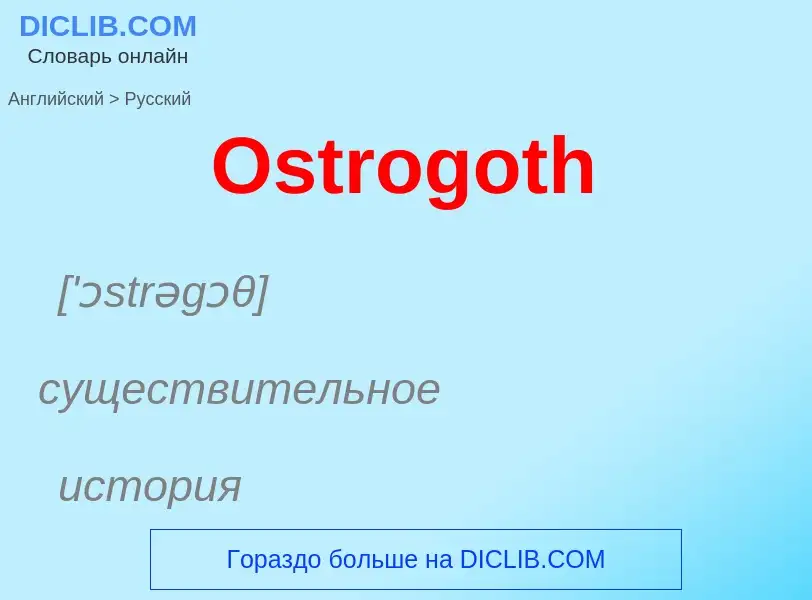Перевод и анализ слов искусственным интеллектом ChatGPT
На этой странице Вы можете получить подробный анализ слова или словосочетания, произведенный с помощью лучшей на сегодняшний день технологии искусственного интеллекта:
- как употребляется слово
- частота употребления
- используется оно чаще в устной или письменной речи
- варианты перевода слова
- примеры употребления (несколько фраз с переводом)
- этимология
Ostrogoth - перевод на русский
['ɔstrəgɔθ]
существительное
история
остгот
[ɔstrə|'gɔθiən-{ɔstrə}'gɔθik]
прилагательное
общая лексика
остготский
Википедия
.jpg?width=120)
The Ostrogoths (Latin: Ostrogothi, Austrogothi) were a Roman-era Germanic people. In the 5th century, they followed the Visigoths in creating one of the two great Gothic kingdoms within the Roman Empire, based upon the large Gothic populations who had settled in the Balkans in the 4th century, having crossed the Lower Danube. While the Visigoths had formed under the leadership of Alaric I, the new Ostrogothic political entity which came to rule Italy was formed in the Balkans under the influence of the Amal dynasty, the family of Theodoric the Great.
After the death of Attila and collapse of the Hunnic empire represented by the Battle of Nedao in 453, the Amal family began to form their kingdom in Pannonia. Byzantine Emperor Zeno played these Pannonian Goths off against the Thracian Goths, but instead the two groups united after the death of the Thracian leader Theoderic Strabo and his son Recitach. Zeno then backed Theodoric to invade Italy and replace Odoacer there, whom he had previously supported as its king. In 493, Theodoric established the Ostrogothic Kingdom of Italy, when he defeated Odoacer's forces and killed his rival at a banquet.
Following the death of Theodoric, there was a period of instability, eventually tempting the Byzantine Emperor Justinian to declare war on the Ostrogoths in 535, in an effort to restore the former western provinces of the Roman Empire. Initially, the Byzantines were successful, but under the leadership of Totila, the Goths reconquered most of the lost territory until Totila's death at the Battle of Taginae. The war lasted almost 21 years and caused enormous damage across Italy, reducing the population of the peninsula. Any remaining Ostrogoths in Italy were absorbed into the Lombards, who established a kingdom in Italy in 568.
As with other Gothic groups, the history of the peoples who made them up before they reached the Roman Balkans is difficult to reconstruct in detail. However, the Ostrogoths are associated with the earlier Greuthungi. The Ostrogoths themselves were more commonly referred to simply as Goths even in the 5th century, but before then they were referred to once, in a poem by Claudian which associates them with a group of Greuthungi, settled as a military unit in Phrygia. Furthermore, the 6th century historian of the Goths Jordanes also equated the Ostrogoths of his time to the Goths ruled by King Ermanaric in the 4th century, who the Roman writer Ammianus Marcellinus had called Greuthungi, and described as living between the Dniester and Don rivers. Huns and Alans attacked the Goths from the east and large groups of Goths moved into the Roman Empire, while others became subservient to the Huns.

.jpg?width=200)
![[[Barbarian kingdoms]] and tribes after the [[fall of the Western Roman Empire]] in 476 [[Barbarian kingdoms]] and tribes after the [[fall of the Western Roman Empire]] in 476](https://commons.wikimedia.org/wiki/Special:FilePath/Europe and the Near East at 476 AD.png?width=200)
![Ostrogothic bow-fibulae (c. 500) from [[Emilia-Romagna]], [[Italy]] Ostrogothic bow-fibulae (c. 500) from [[Emilia-Romagna]], [[Italy]]](https://commons.wikimedia.org/wiki/Special:FilePath/GNM - Gotische Fibeln.jpg?width=200)


![Routes taken by Germanic invaders during the [[Migration Period]] Routes taken by Germanic invaders during the [[Migration Period]]](https://commons.wikimedia.org/wiki/Special:FilePath/Invasions of the Roman Empire 1.png?width=200)
![Ostrogothic belt buckle, [[Pavia Civic Museums]] Ostrogothic belt buckle, [[Pavia Civic Museums]]](https://commons.wikimedia.org/wiki/Special:FilePath/Musei civici6.jpg?width=200)


![Coin of [[Theodahad]] (534-536), minted in [[Rome]] – he wears the barbaric [[moustache]]. Coin of [[Theodahad]] (534-536), minted in [[Rome]] – he wears the barbaric [[moustache]].](https://commons.wikimedia.org/wiki/Special:FilePath/Theodahad 534 536 Ostrogoth minted in Rome.jpg?width=200)
![Mosaic depicting the palace of Theodoric the Great in his palace chapel of [[San Apollinare Nuovo]] Mosaic depicting the palace of Theodoric the Great in his palace chapel of [[San Apollinare Nuovo]]](https://commons.wikimedia.org/wiki/Special:FilePath/Theodoric's Palace - Sant'Apollinare Nuovo - Ravenna 2016 (crop).jpg?width=200)
![Villani's ''Cronica'']] Villani's ''Cronica'']]](https://commons.wikimedia.org/wiki/Special:FilePath/Totila fa dstruggere la città di Firenze.jpg?width=200)
